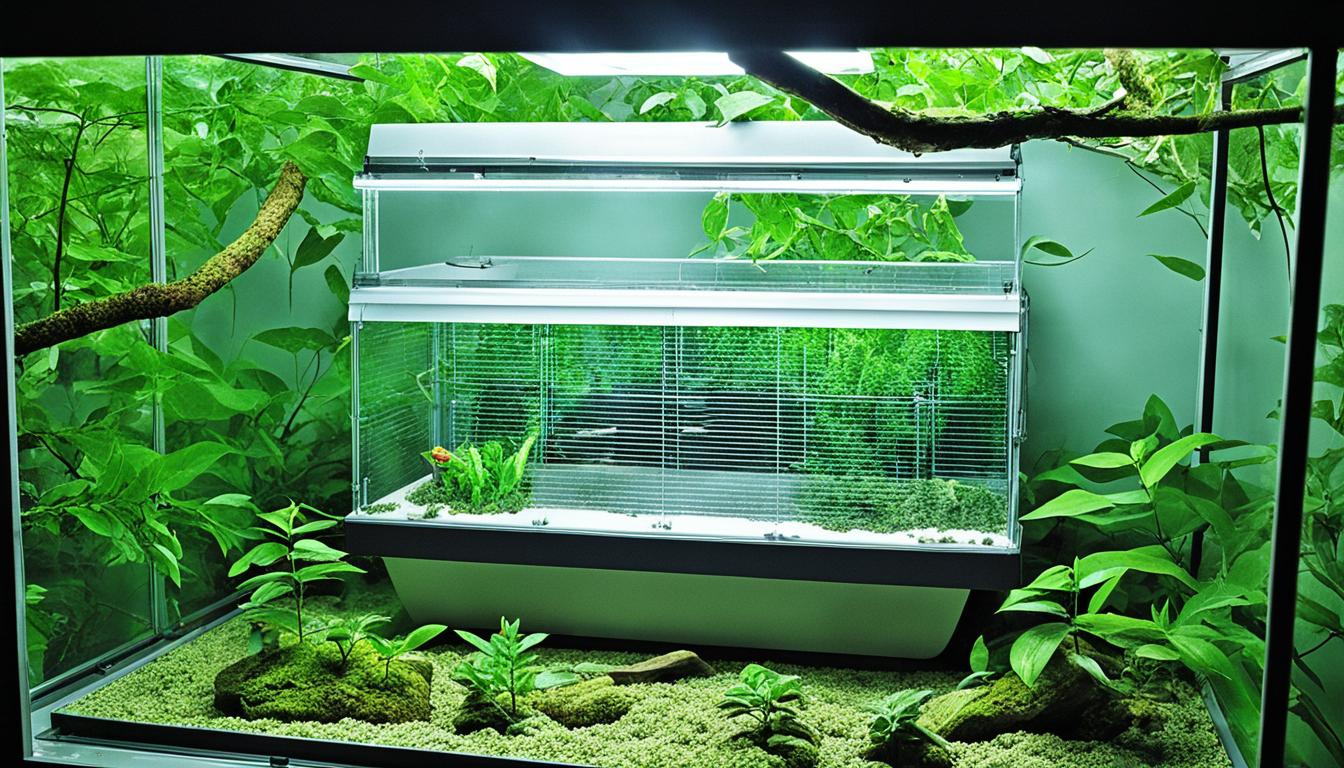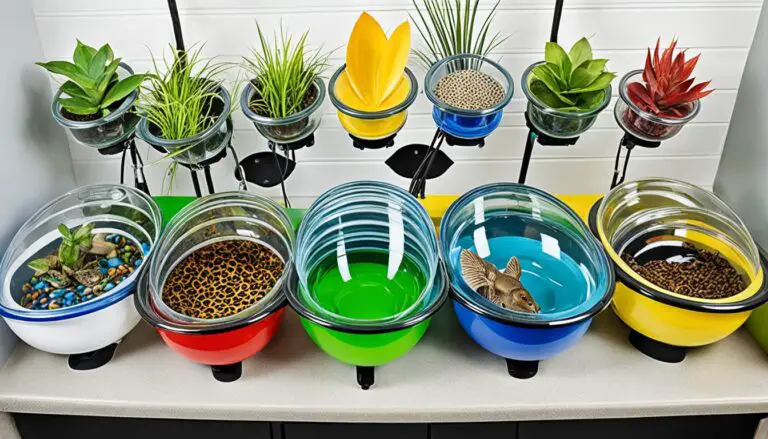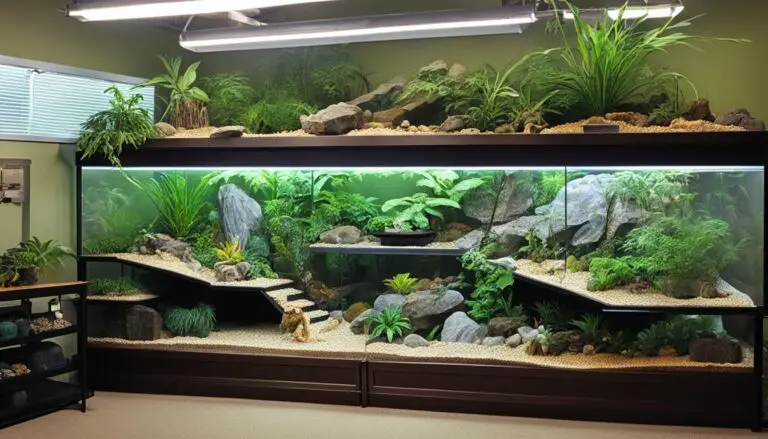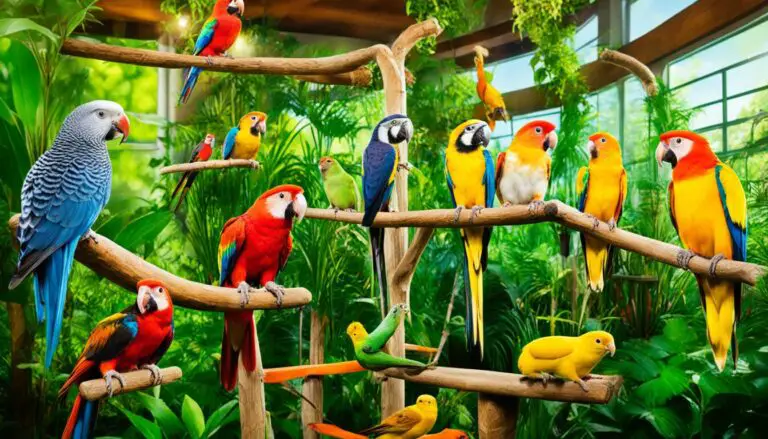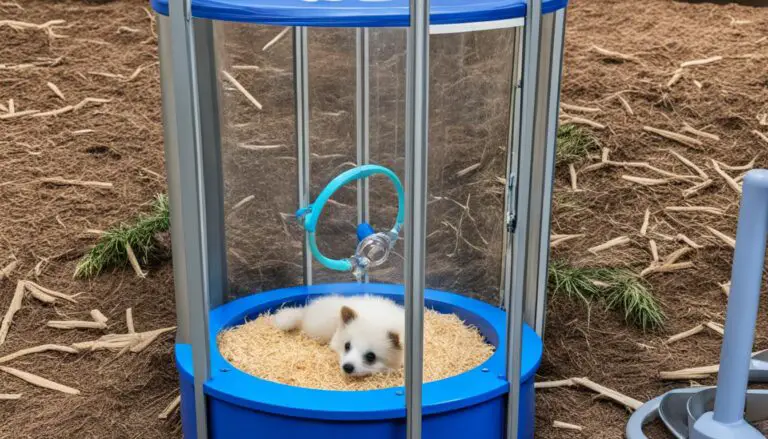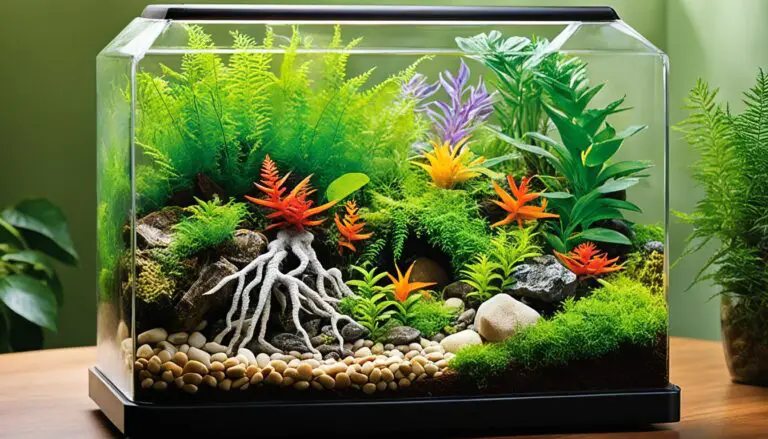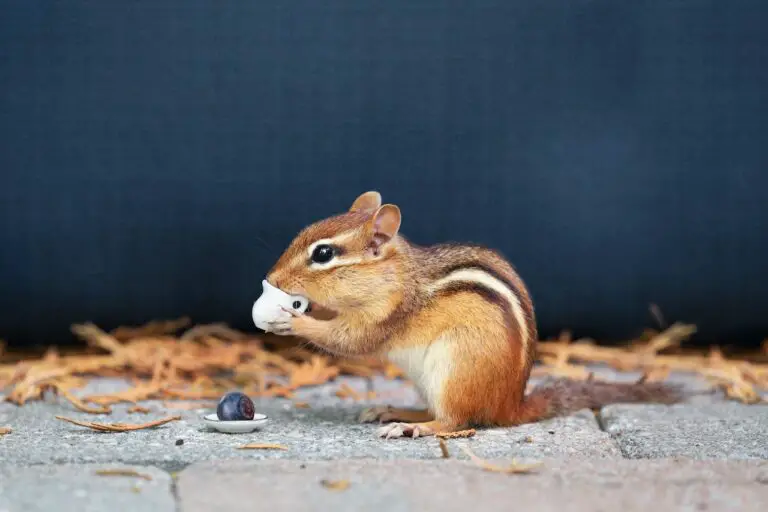Exotic Pet Housing Ventilation Tips & Tricks
Proper ventilation is crucial for ensuring the health and comfort of exotic pets in their enclosures. Without adequate airflow, pets may be at risk of respiratory problems and overheating. By following these tips and tricks, you can optimize ventilation in your pet’s housing to create a safe and comfortable environment.
Key Takeaways:
- Good ventilation is essential for the well-being of exotic pets in their enclosures.
- Adequate airflow helps regulate temperature, remove stale air, and provide fresh oxygen.
- Consider factors such as enclosure size, vent placement, and ventilation system type when optimizing ventilation.
- Options for ventilation include natural vents, mechanical systems like fans, and combination systems.
- Tips for improving air circulation include strategic vent placement, regular cleaning, and utilizing fans or blowers.
Understanding the Importance of Ventilation for Exotic Pets
Proper ventilation is essential for maintaining the overall well-being of exotic pets in their enclosures. Ventilation plays a vital role in regulating temperature, removing stale air, and providing fresh oxygen. Without adequate airflow, pets may be at risk of respiratory problems, overheating, and the accumulation of humidity, odors, and harmful airborne particles. Therefore, it is crucial to understand the importance of ventilation systems designed specifically for exotic pet enclosures to ensure optimal air circulation and create a healthy living space for your beloved pets.
Having a well-ventilated exotic pet living space facilitates several benefits:
- Regulates temperature: Proper airflow helps maintain a comfortable temperature range, preventing overheating or excessive cooling.
- Removes stale air: Continuous ventilation ensures the removal of stale air, reducing the risk of respiratory issues and unpleasant odors.
- Provides fresh oxygen: Adequate ventilation supplies your pets with a steady flow of fresh oxygen, promoting their overall health and vitality.
- Prevents humidity build-up: Ventilation systems help control humidity levels, preventing the development of a humid and potentially harmful environment for your pets.
- Reduces odors: Effective airflow aids in minimizing unpleasant odors that may accumulate in your pet’s enclosure over time.
Implementing appropriate ventilation systems in exotic pet enclosures ensures that your pets can thrive in a safe and comfortable habitat. These purpose-designed systems help maintain optimal airflow, preventing the risks associated with inadequate ventilation.
Take a moment to visualize the impact of proper ventilation for your exotic pets:
“Proper ventilation is like a breath of fresh air for exotic pets, providing them with a healthy, comfortable, and enjoyable living environment.” – Dr. Olivia Martinez, Exotic Pet Specialist
By prioritizing ventilation in your pet’s housing, you can ensure that they enjoy an ideal living space that promotes their physical and emotional well-being.
Factors to Consider for Effective Pet Housing Ventilation
Proper ventilation is essential for creating a comfortable and healthy environment for your exotic pets. When designing the ventilation system for their habitats, it’s important to take several factors into consideration:
- Size of the enclosure: The size of the enclosure will determine the amount of airflow required. Larger enclosures may need more vents or a more powerful ventilation system to ensure adequate air circulation.
- Number and location of vents: The placement and number of vents play a crucial role in directing airflow within the enclosure. Strategic placement of vents ensures proper distribution of fresh air while preventing the formation of stagnant areas.
- Type of ventilation system: Consider the different types of ventilation systems available and choose the one that best suits your exotic pet’s needs. Natural ventilation, mechanical ventilation, or a combination of both can be effective options.
It’s important to find the right balance of air circulation in the habitat. Over-ventilating can lead to temperature fluctuations, while under-ventilating can result in poor air quality. By considering these factors, you can provide adequate ventilation for your exotic pet’s housing, ensuring their comfort and well-being.
To further understand the significance of effective pet housing ventilation, let’s take a look at the following quote:
“Proper ventilation is crucial for exotic pets as it helps regulate temperature, remove stale air, and provide fresh oxygen. Without adequate ventilation, pets may experience respiratory problems and discomfort.” – Dr. Emily Anderson, Veterinarian.
Common ventilation issues and how to address them
While addressing ventilation in exotic pet habitats, it’s important to be aware of common issues and know how to resolve them. Here are a few examples:
| Issue | Solution |
|---|---|
| Inadequate airflow | Ensure proper vent placement and consider installing additional vents or fans if necessary. Remove any obstructions that may be blocking the airflow. |
| Excessive humidity | Use dehumidifiers or increase the number of vents to improve air circulation and reduce humidity levels. |
| Stagnant air | Regularly clean and maintain vents to prevent the accumulation of dust or blockages, facilitating better airflow. |
By being proactive and addressing these issues promptly, you can ensure optimal ventilation in your exotic pet’s housing.
Different Ventilation Options for Exotic Pet Enclosures
When it comes to providing optimal ventilation for exotic pet enclosures, there are various options available to ensure the health and comfort of your pets. The choice of the ventilation system depends on the specific needs of your exotic pets as well as the design of their enclosures. Let’s explore some of the different ventilation options:
Natural Ventilation
One option for ventilating exotic pet enclosures is through natural ventilation. This involves strategically placing vents in the enclosure to allow for the flow of fresh air. By positioning the vents in areas that promote air circulation, you can help remove stale air and odors while bringing in fresh oxygen. Natural ventilation can be particularly beneficial for enclosures located in well-ventilated areas or those with access to outdoor environments.
Mechanical Ventilation Systems
Another option is the use of mechanical ventilation systems, such as fans or blowers, to improve air circulation within the enclosure. These systems can be especially useful in enclosed spaces where natural air movement may be limited. Fans or blowers can help remove stagnant air, regulate temperature, and prevent the buildup of humidity. It is important to choose ventilation systems specifically designed for exotic pet enclosures to ensure the safety and comfort of your pets.
Combination Systems
In some cases, a combination of natural and mechanical ventilation systems may be the best solution. This approach utilizes both strategies to achieve optimal air circulation and maintain a healthy environment for your exotic pets. By combining the benefits of natural ventilation with the supplementary support of mechanical systems, you can create a well-balanced and efficient ventilation setup.
It is essential to consider the specific needs of your exotic pets and the design of their enclosures when choosing the right ventilation option. By providing adequate airflow, you can help prevent respiratory problems, regulate temperature and humidity, and ensure the overall well-being of your exotic pets.
| Ventilation Option | Description |
|---|---|
| Natural Ventilation | Strategic placement of vents to promote natural airflow |
| Mechanical Ventilation Systems | Utilization of fans or blowers to improve air circulation |
| Combination Systems | Integration of both natural and mechanical ventilation for optimal results |
Each ventilation option offers its own advantages, and the best choice will depend on your specific circumstances and the unique needs of your exotic pets. Consulting with a veterinarian or exotic pet specialist can further assist you in selecting the most suitable ventilation system for your pet’s enclosure.

Tips for Improving Air Circulation in Exotic Pet Habitats
To ensure the health and well-being of your exotic pets, it’s crucial to optimize air circulation in their habitats. By implementing a few simple tips, you can create a comfortable environment that promotes proper ventilation.
Strategic Placement of Vents
One of the first steps to enhancing air circulation is to strategically place vents in the enclosure. This allows for the natural flow of air, preventing stagnant pockets and promoting fresh airflow throughout the habitat.
Clean and Maintain Vents Regularly
Regular cleaning and maintenance of vents are essential to prevent blockages that can hinder proper airflow. Clear away any debris or obstructions to ensure that air can freely pass through the vents, promoting optimal ventilation in the habitat.
Consider Fans or Blowers
Consider incorporating fans or blowers into the enclosure to promote air movement. These devices can help create a gentle breeze, improving ventilation and preventing the accumulation of stale air. Be sure to monitor the temperature and keep the airflow at an appropriate level for your exotic pets’ comfort.
Create Airflow Pathways
Creating airflow pathways within the enclosure can further enhance ventilation. Install shelves or perches at different heights to encourage vertical air movement. This not only improves air circulation but also provides opportunities for your pets to explore and exhibit natural behaviors.
By following these tips, you can optimize the air circulation in your exotic pet’s habitat, ensuring a healthy and comfortable living environment.
| Tips for Improving Air Circulation in Exotic Pet Habitats |
|---|
| Strategic Placement of Vents |
| Clean and Maintain Vents Regularly |
| Consider Fans or Blowers |
| Create Airflow Pathways |
Ensuring Safe and Comfortable Ventilation for Exotic Pets
When it comes to designing ventilation systems for exotic pet enclosures, the safety and comfort of your pets should be your top priority. Creating an environment with the ideal ventilation is crucial for maintaining their well-being. By understanding and implementing the right practices, you can ensure that your exotic pets thrive in their habitats.
Avoid creating strong drafts or wind tunnels within the enclosure. These can cause stress and discomfort to your pets, potentially leading to health issues. Opt for ventilation solutions that provide a gentle and consistent airflow throughout the enclosure. This way, you can maintain a comfortable and soothing environment for your exotic animals.
Regular monitoring of temperature and humidity levels is essential to ascertain that they align with the optimal range for your pets’ specific needs. Fluctuations in these factors can result in discomfort and health problems for your pets. By keeping a close eye on these conditions, you can make any necessary adjustments to ensure the ideal environment.
Best Practices for Ventilating Specific Exotic Pet Enclosures
Proper ventilation is essential for maintaining the health and well-being of exotic pets in their enclosures. Each type of exotic pet has unique ventilation requirements to ensure they thrive in their habitats.
Reptile Habitats
Proper ventilation for reptile habitats involves creating temperature gradients through strategic placement of vents. This allows for natural airflow and helps regulate the temperature and humidity levels. By promoting optimal ventilation, you can create a comfortable and healthy environment for your reptile friends.
Bird Cages
Ventilation in bird cages is crucial for preventing the accumulation of dust and feathers. Birds are known to produce dander, feathers, and other particles that can impact their respiratory health. Opting for bird cages with built-in ventilation systems ensures proper airflow, reducing the risk of respiratory issues and keeping the cage clean.
Mammal Enclosures
When it comes to mammal enclosures, adequate airflow is necessary to minimize odors and maintain a fresh environment. By prioritizing proper ventilation, you can prevent the buildup of stale air and create a comfortable habitat for your small mammal companions.
Understanding the specific ventilation needs of each exotic pet allows you to tailor the ventilation system accordingly. Whether it’s creating temperature gradients for reptiles, preventing dust accumulation in bird cages, or minimizing odors in mammal enclosures, optimizing ventilation is key to ensuring the well-being of your exotic pets.

Common Ventilation Issues and How to Address Them
Despite your best efforts to ensure proper ventilation in your exotic pet enclosures, it’s not uncommon for ventilation issues to arise. Understanding these common problems and knowing how to address them is essential for maintaining a healthy and comfortable environment for your pets.
Inadequate Airflow
One of the most prevalent ventilation issues is inadequate airflow. Insufficient air circulation can lead to the accumulation of stale air, increased humidity levels, and even respiratory problems for your exotic pets.
To troubleshoot inadequate airflow, first, check the placement of vents in the enclosure. Make sure that they are strategically positioned to allow for optimal air movement. Consider adding additional vents if necessary to improve ventilation.
If adjusting the vent placement doesn’t solve the problem, you may need to upgrade the ventilation system. Mechanical ventilation options such as fans or blowers can help improve airflow within the enclosure. Consult with a veterinarian or exotic pet specialist for guidance on choosing the right ventilation system for your specific needs.
Excessive Humidity
Excessive humidity can create a damp environment within the enclosure, leading to mold growth, respiratory issues, and discomfort for your exotic pets.
To address high humidity levels, ensure proper ventilation by allowing fresh air to circulate within the enclosure. Consider adding dehumidifiers or moisture-absorbing materials to help regulate humidity levels.
Monitoring the enclosure’s temperature and humidity regularly and making adjustments as needed will help maintain a suitable environment for your pets.
Stagnant Air
An issue commonly encountered in exotic pet enclosures is stagnant air. Stagnant air occurs when there is limited movement or exchange of air within the enclosure, resulting in poor air quality and potential health problems.
To resolve stagnant air, it’s crucial to increase air circulation. You can achieve this by using fans or blowers to promote airflow. Additionally, consider incorporating shelves or perches that create pathways for air to flow throughout the enclosure. Regular cleaning and maintenance of the enclosure, including removing any waste or debris, are also essential for preventing stagnant air.
“Proper ventilation is vital for creating a healthy and comfortable habitat for your exotic pets.”
Remember, if you encounter ventilation issues in your exotic pet enclosure, it’s essential to identify the root cause and take appropriate action promptly. Adjusting vent placement, upgrading ventilation systems, or modifying the enclosure design may be necessary. Consult with a veterinarian or exotic pet specialist to ensure you address the specific ventilation problems effectively.
Incorporating Ventilation into Pet Enclosure Design
Proper ventilation is essential when designing an exotic pet enclosure. By considering ventilation from the initial design stages, you can create a comfortable and healthy living space for your pets. Incorporating vents, openings, or mesh panels into the enclosure allows for sufficient airflow, ensuring optimal air circulation.
Strategic placement of vents and careful consideration of the overall layout are crucial factors in maintaining the desired temperature and humidity levels within the enclosure. By integrating ventilation systems into the design, you can prevent the buildup of stale air, humidity, and harmful particles that may have adverse effects on your exotic pets’ respiratory health.
Optimizing ventilation not only serves the physical well-being of your pets but also contributes to their overall happiness and comfort. It helps regulate temperature, removes unwanted odors, and provides fresh oxygen, recreating a natural habitat environment.
When incorporating ventilation into your pet enclosure design, consider the specific needs of your exotic pets. Different species may require varying levels of airflow and humidity control. Consulting with a veterinarian or an experienced exotic pet specialist can provide valuable insights tailored to your pets’ unique requirements.
By prioritizing proper ventilation during the enclosure design process, you can ensure a functional and comfortable living space for your exotic pets, promoting their overall health and well-being.
Conclusion
Ensuring proper ventilation in your exotic pet enclosures is essential for the health and well-being of your pets. By understanding the significance of ventilation, considering the unique needs of your pets, and implementing suitable ventilation systems, you can create a safe and comfortable living environment.
Regularly monitoring and maintaining the ventilation systems is crucial to ensure optimal airflow. Make adjustments as needed to maintain the ideal conditions for your pets. With proper ventilation, your exotic pets will thrive in their habitats, enjoying fresh air and a conducive living space.
Remember to prioritize the safety and comfort of your pets when designing ventilation systems. Avoid creating drafty or windy environments that can cause stress. Opt for gentle and consistent airflow throughout the enclosure for their utmost well-being.
By following these ventilation tips for exotic pet owners, you can optimize the air circulation in your pets’ habitats, creating a healthy and enjoyable living space for them. So, take the necessary steps to provide your exotic pets with the ventilation they need and watch them thrive in their exotic habitats.
FAQ
Why is proper ventilation important for exotic pets?
What factors should be considered for effective ventilation in pet housing?
What are the different ventilation options for exotic pet enclosures?
How can I improve air circulation in my exotic pet habitat?
How can I ensure safe ventilation for my exotic pets?
Are there specific ventilation requirements for different types of exotic pets?
What are common ventilation issues in exotic pet enclosures and how can they be addressed?
How can I incorporate ventilation into the design of my pet enclosure?
Why is proper ventilation important for the health and well-being of exotic pets?
What are some tips for optimizing ventilation in exotic pet enclosures?
Source Links
- https://www.reptile-cage-plans.com/emails/howmuchventilation.html
- https://www.wacspringhill.com/blog/260572-tips-for-exotic-pet-care
- https://www.swanimalhospital.net/exotic-pet-care-tips
Peter Stones is the founder of Exotic Pets Place, the leading online resource for exotic pet care information.
With over 10 years of hands-on exotic pet ownership experience, he is deeply passionate about sharing his expertise to help others properly care for their unusual pets.
When he's not writing extensively researched articles or connecting with fellow exotic pet enthusiasts worldwide, you can find Peter at home tending to his own beloved menagerie of exotic animals.

